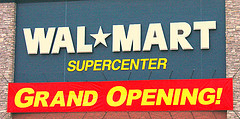 The National Retail Federation (NRF) has released its ranking of top U.S. retailers for 2009, and the power players are primarily discounters and grocery retailers. Given the challenging economy in the United States that continued in 2009, it’s not surprising that even discount superstores saw a shift in sales from non-essentials to essentials (such as grocery products like food) leading sales figures.
The National Retail Federation (NRF) has released its ranking of top U.S. retailers for 2009, and the power players are primarily discounters and grocery retailers. Given the challenging economy in the United States that continued in 2009, it’s not surprising that even discount superstores saw a shift in sales from non-essentials to essentials (such as grocery products like food) leading sales figures.
Check out the list of the top 10 retailers in the U.S. according the the NRF report below (via TheStreet):
1. Walmart
Is anyone surprised that Walmart is in the top spot? Probably not. The interesting part of Walmart’s story in 2009 is that much of the company’s growth has actually been overseas, but U.S. sales are still strong. The company’s grocery business accounted for more than half of its 2009 sales.
2. Kroger
Kroger is a grocery retailer that stays strong despite competition from discounters like Walmart and Target.
3. Target
If Walmart is on a list, it’s usually safe to assume that Target won’t be far behind. Target has been focusing on growing its own grocery segment, PFresh. Do you smell a trend yet?
4. Walgreen
Walgreen jumped two spots on the NRF ranking thanks to opening new brick and mortar stores and a couple of sizable acquisitions.
5. Home Depot
As you’d expect, Home Depot’s business in the U.S. depends on the housing market, which has been struggling. Despite the economy, Home Depot managed to take the fifth spot on the NRF list.
6. Costco
Another discounter that points to its grocery section as the reason the company’s volume grew in 2009 is Costco.
7. CVS Caremark
Just as Walmart and Target go hand-in-hand in the world of big-box discounters, CVS and Walgreen go together in the world of pharmacy retailers. Thanks to its own acquisitions, CVS managed to grow its sales by 13% in 2009.
8. Lowe’s
Walmart and Target, CVS and Walgreen, Lowe’s and Home Depot. These are competitors that constantly try to differentiate themselves from each other. Lowe’s attributes some of its recent growth, despite the continued struggles in the U.S. housing market, to government stimulus programs.
9. Sears
Sears has been experiencing dropping sales but still takes the #9 spot on the NRF list of top retailers in the U.S. Sears is hoping some of the company’s new incentives, promotions and programs (including an online marketplace, appliance layaway program, and streaming movie and TV downloads partnership) will help boost sales in the near future.
10. Best Buy
Big-box electronic stores have lost a lot of popularity in recent years, and only two make the NRF list of top 100 retailers in the U.S. in 2009. Best Buy is one of those electronics retailers, which ranks #10 with approximately one-third of the company’s sales coming from consumer electronics and another third coming from home office products. The company saw strong sales in 2009 of high-definition televisions, netbook computers, and smartphones. However, sales of entertainment software such as video games, CDs and DVDs were down. Best Buy has some big plans in the works for increasing sales in 2010 and beyond, including a video download service (to compete with Netflix and similar services from Blockbuster) and new store openings as well as 1,000 new Best Buy Mobile stores.
What do you think? Any surprises on this list of top U.S. retailers by sales volume? What company would you like to see drop from this list or added to this list in the future? Leave a comment and share your thoughts.
Image: Flickr
Susan Gunelius is the author of 10 marketing, social media, branding, copywriting, and technology books, and she is President & CEO of KeySplash Creative, Inc., a marketing communications company. She also owns Women on Business, an award-wining blog for business women. She is a featured columnist for Entrepreneur.com and Forbes.com, and her marketing-related articles have appeared on websites such as MSNBC.com, BusinessWeek.com, TodayShow.com, and more.
She has over 20 years of experience in the marketing field having spent the first decade of her career directing marketing programs for some of the largest companies in the world, including divisions of AT&T and HSBC. Today, her clients include large and small companies around the world and household brands like Citigroup, Cox Communications, Intuit, and more. Susan is frequently interviewed about marketing and branding by television, radio, print, and online media organizations, and she speaks about these topics at events around the world. You can connect with her on Twitter, Facebook, LinkedIn, or Google+.